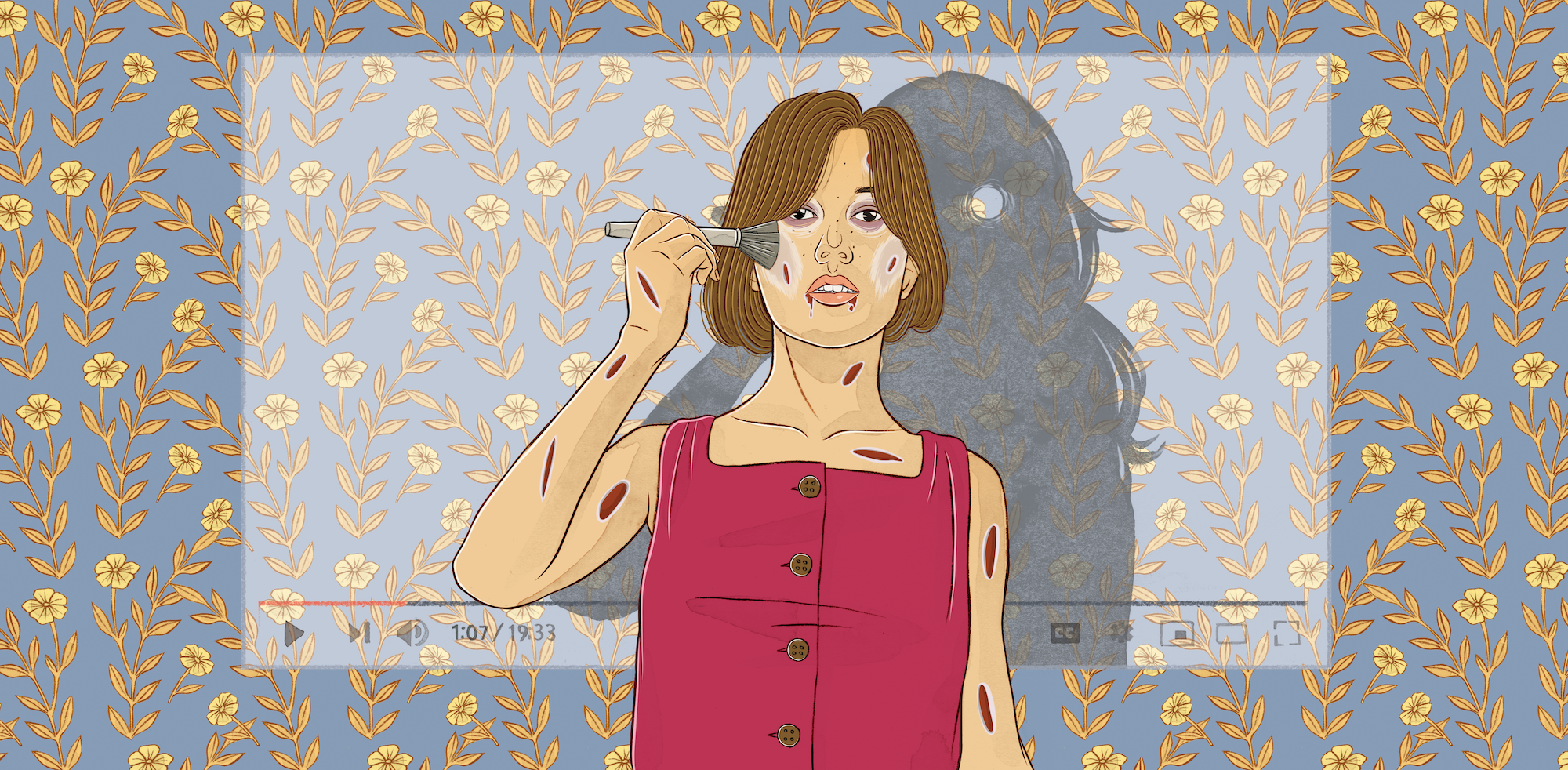There Is No Beauty Without Resistance
by Dominica Phetteplace
Illustrated by Stephanie Singleton | Edited by Julia Rios
Copyedited by Chelle Parker
December 2019
In the summer after abortion was outlawed, a lot of us went wild with our makeup. We started wearing thick stripes of dark eyeliner, or we drew teeth on our lips. Blush came in lavenders and pale greens. We started painting ourselves like cute zombies. Open wounds on the face but with splashes of festive glitter all over.
I wanted to paint my lips black and my nails pink, but it wasn’t allowed in my house and anyway, I didn’t know how. But what I couldn’t figure out for myself, what my friends couldn’t teach me, I could learn on YouTube.
My favorite vlogger was Jazmyn Margarita. She started with the basics. The basics were skincare and how to shoplift the products you needed. She didn’t believe in stealing, not if you could afford to pay. But she knew a lot of us couldn’t afford to and she said that beauty was a human right.
She said you had to prep your canvas. She said you had to know your angles. She said it wasn’t disguising your outsides, it was showing your insides. Don’t trust anyone who tries to filter you. Filter yourself. Apply the filter of your choice directly to your face.
She didn’t become truly famous until she started posting her abortion tutorials. She started with several forms of menstrual extraction. Then she moved on to chemical abortion and which medications could induce miscarriage. These were taken down by YouTube but found a new home on PornHub. She talked about birth control, told us what our options were. None of it was completely safe, she warned us. Nothing was safe. Not sex, not sexting, not existing. That didn’t mean we shouldn’t try and protect ourselves.
Her tutorials were classified as hate speech against the unborn. She became a wanted criminal. Still she posted more videos. You could contour yourself into a whole new identity, one that would fool the facial recognition software installed in all security cameras. Large flakes of glitter applied strategically to your face could act like antagonistic pixels, the kind that perturbed deep neural networks and kept algorithms from classifying pictures of you correctly. Nobody knew how data inference via machine learning worked, this mystery allowed us to disrupt the constant surveillance we were all under. There was no beauty without privacy.
There were rumors on the message boards. That she had fled to Canada. Or the UK. Or been taken in by a Libertarian tech bro. That she was never real in the first place, but one of those computer generated ‘virtual celebrities.’ No one ever saw her in public, but still she posted.
I wondered how she did it. She was a superhero, but superheroes couldn’t do it alone. They needed butlers and billion dollar fortunes. I wrote fan fiction about how she had made her money from trading cryptocurrencies. She had two boyfriends: Neymar and Harry Styles. Her butler was a self-aware robot that she had freed from indenture.
I exfoliated and moisturized. I plucked my brows. I wore tight clothes under my loose clothes. I wasn’t like her, not brave enough to openly break the rules. I looked for ways to disobey without being flagrantly disobedient. Jazmyn’s tutorial on posture and body language changed my life. My parents warned me that I was becoming unattractive. Maybe so. But Jazmyn always said that true beauty requires an element of something repulsive.
The Jazmyn from my stories walked the streets, unrecognized. She could be anybody. I imagined a tutorial that could make her look like me. I used Tor and shared PGP keys, a thing Jazmyn had taught me about, to post my stories on the fan forums without getting caught. My stories were my art. My stories were important because they always wrote happy endings for Jazmyn. Not like ‘real life,’ where the state-sponsored propaganda outlets featured reports of her arrest and capture. Fake news. Her publicly broadcasted torture? Also fake. In my stories, the reason she stopped posting is because she moved to my town. She wanted a normal life. She enrolled in my school and became my best friend.
I got older and things got worse. I couldn’t think of any more stories, and anyway, it had been years since she last posted. I started to think she really had died. But then I got even older, and after some hard-fought victories, I felt her very much alive in me. I figured out a happy ending that might actually be true.
I wrote a story about how she escaped captivity and uploaded herself to the cloud. How she distributed herself across billions of tiny hard drives, and how many of us implanted those hard drives directly into our own bodies so we could wear her like we wore our memories. Invisible, like our concealer. Ever present, like our long-lasting lipstick. She saw us through our screens and through our mirrors. She hadn’t just seen the things we had lost. She had also survived long enough to see the things we won back.


